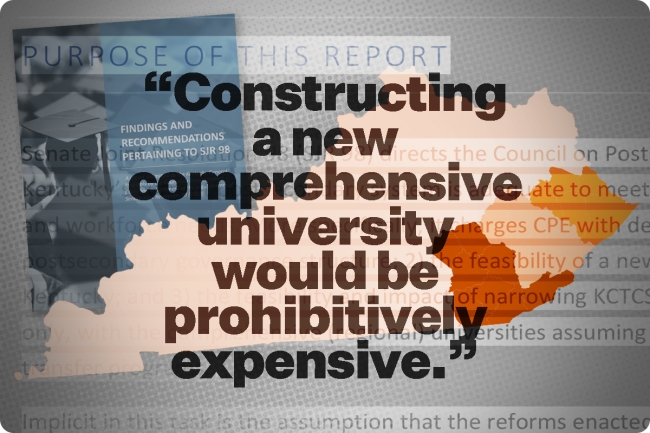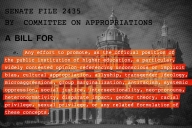You have /5 articles left.
Sign up for a free account or log in.

The Kentucky Council on Postsecondary Education released in late November its report exploring the prospect of establishing a new state college.
Photo illustration by Justin Morrison/Inside Higher Ed | Wikimedia Commons | Kentucky CPE
As colleges across the country face the ongoing toll of enrollment declines and increased budget challenges, many state education officials worry their local institutions could be the next to shutter. Lawmakers in Kentucky, however, are considering opening a new university instead.
State Assembly members say the concept, formalized through legislation approved in March, was spurred by the “conspicuous” lack of a public four-year institution in the southeastern region of the state, which has hampered local economic development.
The resolution, which passed unanimously, charged the Kentucky Council on Postsecondary Education, or CPE, with investigating three options: establishing an entirely new college, creating a new branch campus of one of the state’s eight established four-year universities or acquiring an existing private institution.
But a report by the CPE, based on a study conducted by Ernst & Young and released in late November, argues that each of the three models posed by state lawmakers is “in some way problematic.”
“Constructing a new comprehensive university would be prohibitively expensive … It seems unlikely a new regional satellite would receive adequate resources … [and] acquisition would be a complicated legal process,” the report reads.
Instead, the CPE suggested an alternative, “preferred approach”—expanding a pre-existing community college into a stand-alone four-year institution. But the council said it could not provide its full endorsement without further research and a comprehensive strategy.
“What we do know is there surely is a need to build economic development in southeastern Kentucky, and there is a need for most of our citizens to be reskilled or to get a college credential of some sort that leads to that,” said CPE president Aaron Thompson. “How we offer that, then, needs to be looked at in greater detail.”
A Target College
Jennifer Lindon, president of Hazard Community and Technical College, the institution cited as most ideal for the CPE’s “preferred approach,” said she is “very excited” about the possibility of additional educational opportunities in southeastern Kentucky.
The small Appalachian town of Hazard is centrally located in a blue-collar region whose economy was historically driven by the now mostly defunct coal industry. The area is known as a “postsecondary desert” and has a bachelor’s degree attainment rate just under 24 percent.
“We don’t have a public four-year university that serves us,” said Lindon, who was raised in Hazard. “There’s Eastern Kentucky University and then there’s Morehead State University. From most of the counties here in southeast Kentucky, that’s at least going to be a two-hour drive. “
She said there are some private colleges in the area that are closer, “but of course, with most private institutions, you’re going to pay higher tuition.”
Under the CPE’s current recommendations, the new institution would offer a select handful of bachelor’s degrees, “in line with area workforce demand,” and continue to offer a variety of technical programs.
These would not necessarily be the first bachelor’s degree options offered in association with the community college. An on-campus advising office known as the University Center of the Mountains, or UCM, helps students pursue studies in any of 48 degree programs through 11 different four-year partner institutions offering mostly online and limited hybrid and in-person programs.
CPE considered solely expanding the services of UCM, which would be less costly than a stand-alone institution, but that would not provide the desired level of face-to-face instruction. Thompson said he hopes to see both the expansion of Hazard to a stand-alone institution and an increase in the scope of its UCM partnerships.
Pushing For Rural Equity
Andrew Koricich, executive director of the Alliance for Research on Regional Colleges, said he is glad about the consensus on the need for more higher ed options in the region, but he is also “frustrated” by the CPE recommendation to expand Hazard Community and Technical College.
“They talk a lot about financial viability, but the reality is as a public entity, it is a public service. It is not a corporation. It is not a for-profit business. Its job is not to make money,” Koricich said. “It is there to provide a service to the public, just like K-12 schools.
“This whole framing, to me, is that we can’t afford to do it … But that automatically assumes that we should only be doing this if it’s seen as cost-effective,” he added.
Koricich, who is also an associate professor of higher education at Appalachian State University, believes the lack of funding is a matter of “political will” and hesitation by Kentucky lawmakers to raise taxes on wealthy individuals and corporations.
“Rural communities deserve the same things that cities and suburbs deserve”—like a comprehensive university, he said.
Koricich also suggested that turning a private institution public may not be as difficult as the CPE portrayed. He pointed to the University of Tennessee system’s purchase of Martin Methodist College in 2021 to form the University of Tennessee Southern. It was the first addition to the university system in more than 50 years and was designed to address a similar postsecondary desert in south-central Tennessee.
“They say that they don’t have a college that demonstrated interest and that there are, basically, insurmountable legal hurdles. That is not true,” he said. “University of Pikeville is a private Presbyterian College … They aren’t looking for a bailout from the state, but that doesn’t mean that there aren’t conversations to be had.”
He acknowledged that although there would be legal hurdles, “they are not the Great Wall.”
Further Exploration Needed
Thompson of CPE said that regardless of the model pursued, the estimated cost of the endeavor in relation to the overall sustainability of the institution needs to be further explored.
“We have to see if whatever model we choose actually lends itself to that output that we ultimately want,” he said.
An existing analysis of expected costs, as well as enrollment projections and economic outcomes, are rudimentary thus far, Thompson said. He estimated that the recurring operational cost of expanding Hazard to a stand-alone four-year college would be around $18 to $20 million higher than what the college currently spends annually. Most of that cost would be related to compensation for about 80 additional faculty and staff members. However, funds would also be necessary for infrastructure transitions such as software for learning management systems and payroll, as well as the loss of buying power and shared services, such as legal representation, through the Kentucky Community and Technical College System.
The biggest-ticket item, in addition to operational costs, would be funding the construction of a new residence hall to attract rural students for whom the current daily commute to campus is a barrier. Construction estimates are approximately $18.2 million.
‘Incremental’ Steps Forward
State representative James Tipton, a Republican and co-chair of the Interim Joint Committee on Education, said he has read the CPE’s recommendations and agrees that further studies are needed to explore questions such as whether there are enough students to sustain the college and what workforce needs deserve primary focus. He believes the Assembly is unlikely to take further steps during this legislative session beyond authorizing additional research.
“We don’t want to start a university and see it fail. So we want to make sure that everything’s in place, the building blocks are there and that we’re able to provide the kind of financial support to get it off successfully,” Tipton said. “If it does go forward, I see it going forward incrementally.”
State senator Robert Stivers, president of the Senate and sponsor of the legislation, Joint Resolution 98, made similar comments at a Jan. 3 press conference.
“The need is definitely there. Potential location is there. But the fiscal realities, the delivery mechanism, all that needs to be fleshed out,” Stivers said. “I think it’s premature to say [whether] there would or would not be [such a college], but I think there’ll be further discussion … in future years.”
Ryan Quarles, the recently appointed president of the Kentucky Community and Technical College System, said he is “appreciative” of the CPE’s study and looks forward to seeing what the Legislature does with the results.
Quarles said he couldn’t yet speculate on exactly what impact the proposal would have on the system, but he did note that “any strategic change to an existing community college would trigger a series of policy discussions.
“As a former legislator and statewide elected official, it’s important that we put the needs of the commonwealth first, over what sometimes can be shortsighted decisions,” he said. “If it’s the best decision for the commonwealth, of course we’ll implement what the policymakers in the General Assembly instruct us to do.”








